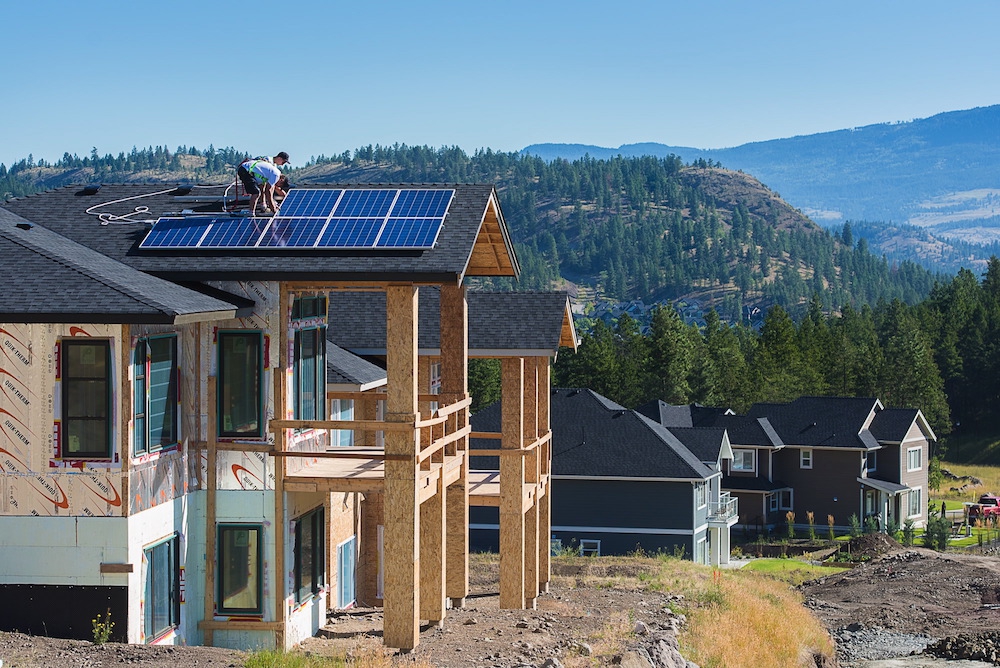
News
A mere $35K extra buys you Wilden’s “Home of Tomorrow”
January 23, 2017 - Recent EnerGuide testing has shown the Home of Tomorrow—one of two homes that make up the Wilden Living Lab project—to be 52% more energy-efficient than a standard home constructed to today’s building code... yet it costs just $35,000 more.
January 23, 2017 By Anthony Capkun
 The Home of Tomorrow sports CSUN Quasar 260 Solar panels connected to a Fortis net meter. Photo courtesy Okanagan College.
The Home of Tomorrow sports CSUN Quasar 260 Solar panels connected to a Fortis net meter. Photo courtesy Okanagan College. The Home of Today and the Home of Tomorrow—two houses constructed side-by-side in the Wilden neighbourhood—are part of a real-world study on homebuilding that compares the energy usage patterns of identical structures built with different energy-efficient technologies.
The initiative is collaborative three-year learning and research project by Wilden developer Blenk Development Corp., AuthenTech Homes, UBC Okanagan, Okanagan College and FortisBC.
Following the completion of construction of both homes in early November, the Living Lab partners enlisted an energy evaluation company to analyze the performance of each home based on the Government of Canada’s EnerGuide standard ratings for new homes.
Gilles Lesage, operations manager of Total Home Solutions, conducted the testing on insulation levels, airtightness, windows and door types, and space and hot water heating systems.
Built to current building code standards, the Home of Today achieved an EnerGuide rating of 110 GJ/year and GHG emissions of 3.0 tonnes/year in the energy audit. Meantime, the Home of Tomorrow achieved an EnerGuide rating of 47 GJ/year and GHG emissions of just 0.3 tonnes/year.
“This project shows the impact that’s made when homes are built with efficiency in mind right from the planning stage,” said Danielle Wensink, director, energy conservation & management for FortisBC. “We believe it’s well worth supporting forward-thinking projects like this that advance energy-efficient construction in the region.”
The Home of Tomorrow was built with several energy-efficient components that exceed current building code requirements, including geothermal heating and cooling, heat pump water heater, triple-glazed windows and an insulated concrete form foundation. (READ MORE stats, at bottom.)
The Home of Today, meantime, was built to the current B.C. Building Code specs, allowing it to act as a baseline comparison.
The Wilden Living Lab project has also integrated students from both post-secondary institutions for hands-on participation. Students from Okanagan College’s Sustainable Construction Management and Residential Construction programs worked with local builder AuthenTech Homes on the construction of the homes.
In Spring 2017, the homes will start collecting real-life data, when they are sold at market value, and the prices have recently been released.
“The Home of Today is advertised at $765,000, and the Home of Tomorrow at $800,000. Both homes have 2700 sf of finished floor space,” reports Tory Braun, marketing & communications specialist with Okanagan College.
The residents who move in will have their consumption monitored on the meters and sensors installed throughout the homes. Researchers from UBC Okanagan’s School of Engineering will spend the next three years analyzing and comparing the collected data to learn how these building technologies can influence energy consumption.
“The Wilden Living Lab will provide real life energy consumption data over the next three years, and help us understand and compare the conventional and advanced local construction practices and energy-efficient appliances, and its relationship to energy bills,” explained UBC Okanagan’s Dr. Shahria Alam, who is leading the monitoring effort.
The findings from UBC will be published on the Wilden Living Lab website. FortisBC will offer open houses to the public in February.
Home of Tomorrow at-a-glance*
• HVAC: 5 series: ground source heat pump c/w ECM variable-speed blower
• Zoned ducting (1 @basement/1 @ main)
• Solar panels: CSUN Quasar 260, connected to a Fortis net meter
• Life Breath RNC155 dedicated HRV system
• GE Geospring Pro heat pump water heater
• Fireplace: Marquis 46 Skyline 2 ZRB46NE gas direct vent
• Plumbing: water-saving toilets and faucets
• Windows: vinyl triple-glazed windows c/w double 366 low E
• 12-in. insulated concrete form (ICF) foundation walls at entire basement level
• QuikTherm 2-in. rigid foam wall system, c/w R14 batt insulation on main floor
• R-20 batted and R-50 blown in ceilings (total R-70), 2 lb urethane spray at joist ends
• Lighting: LED
• Appliances: induction range, double ovens, 5-door fridge, heat pump dryer (which are also condensing units, and do not require outside venting)
• Energy Star-rated hood fan with LED lighting
• Energy-efficient dishwasher
• Energy management and climate control system by Thermo Matrix
* Subject to change
Photo 1: The Home of Tomorrow’s is just $35,000 more than the Home of Today, yet boasts 52% greater energy efficiency. Wilden Living Lab website.
Photo 2: The Home of Tomorrow sports CSUN Quasar 260 Solar panels connected to a Fortis net meter. Photo courtesy Okanagan College.
Photo 3: QuikTherm 2-in. rigid foam wall system envelopes the structure. Photo courtesy Okanagan College.
Print this page
